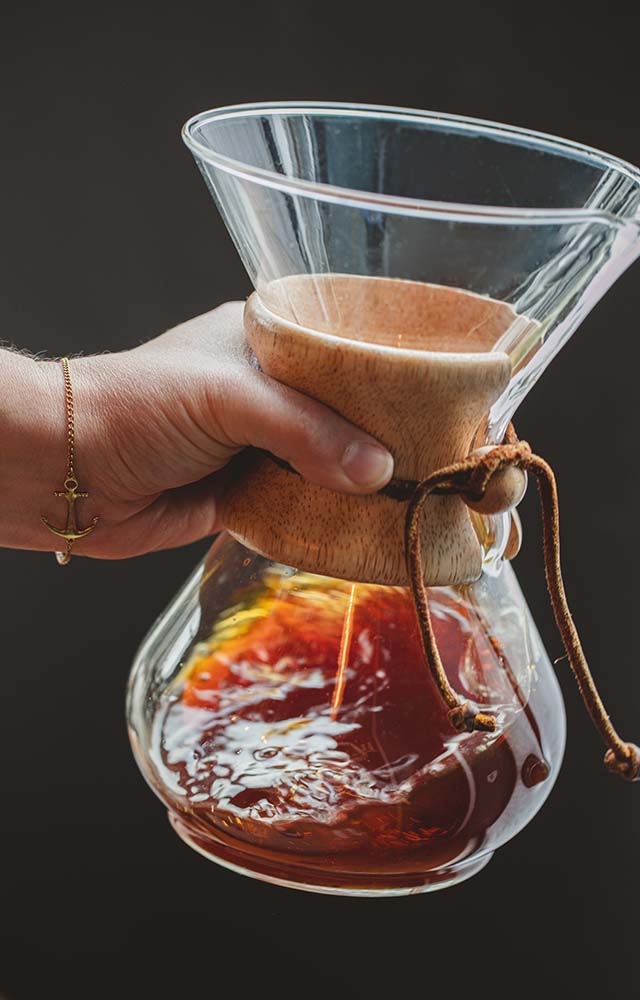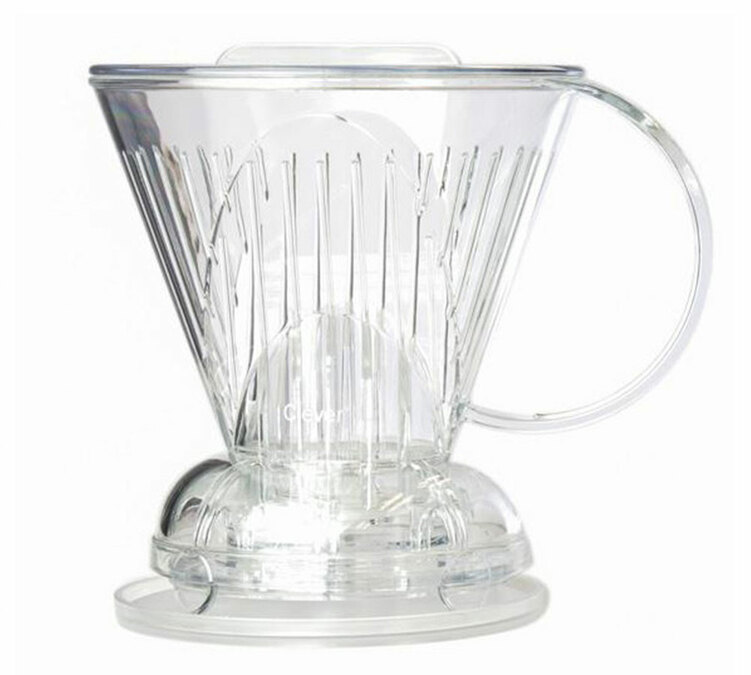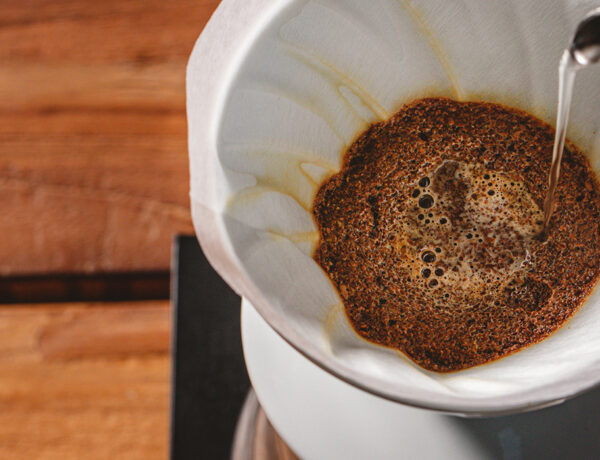
- Home
- How to choose your pour-over method?

How to choose your pour-over method?
Written by Jigisha
Reading time 6 minFor the past few years, a new trend has been restoring the prestige of filter coffee: pour-over coffee. It’s a way to take the time to make a cup of coffee: patiently brewed, the drink reveals aromas that were previously unknown. This marks the grand return of pour over coffee brewing, and we at Maxicoffee are here to explain everything.
What is Pour-Over Coffee?
Pour-over coffee lives up to its name: it’s an extraction method that involves carefully pouring water over ground coffee..
Also known as filter coffee, it is prepared based on the principle of leaching. This term refers to the process of pouring boiling water through ground coffee within a filter. The filter method takes more time, as the coffee drips slowly under the influence of gravity rather than pressure.
The cup obtained with a pour-over method tends to be less bitter. It is often said that this method allows for one of the purest results in the cup.
The Origins of Pour-Over Coffee
Jean-Baptiste de Belloy, Archbishop of Paris, is credited with revolutionizing coffee brewing around 1800 by inventing a coffee percolation system. Prior to his innovation, coffee was merely infused. His creation, known as the “Dubelloire,” is considered the first coffee maker, significantly enhancing the way coffee was prepared and enjoyed.
The Six Iconic Pour-Over Methods

The Chemex®
What is a Chemex®? The Chemex® is the iconic pour-over coffee maker invented in 1941 by Peter Schlumbohm..
Preparation Method: Heat some water, prepare your ground coffee (coarse grind size), and place a filter in your Chemex®. Once these preparation steps are done, rinse your filter with hot water, empty the water, then add the ground coffee. Proceed with multiple pours and let it infuse. Find all the steps to prepare coffee with a Chemex® in our dedicated article.
Cup Result: You will get a very smooth coffee, similar to an infusion, light in body, with unparalleled aromatic strength.

The V60
What is a V60? The V60 is a dripper coffee maker that allows for a gentle, gradual, and controlled extraction. The user controls the flow rate, temperature, and brewing time.
Preparation Method: Heat some water, prepare your ground coffee (medium-fine grind size), and place a filter in your V60. Once these preparation steps are done, rinse your filter and add the ground coffee. Proceed with multiple pours and let it infuse. Find all the steps to prepare coffee with a V60 in our video.
Cup Result: You will get a subtle and refined coffee, with good aromatic strength and a pronounced body.

The French Press
What is a French Press? Also known as a cafetière, the French Press is probably one of the simplest methods to use for preparing filter coffee.
Preparation Method: Heat some water and prepare your ground coffee (coarse grind size). Once these preparation steps are done, preheat your French Press with hot water, empty it, then add the ground coffee. Proceed with multiple pours and let it infuse for up to 8 minutes. Finally, press down to the bottom. Find all the steps to prepare coffee with a French Press in our dedicated video.
Cup Result: You will get a coffee with beautiful aromatic strength and more body. This is why French Presses are often used to enjoy single-origin coffees.

The Vacuum Coffee Maker
What is a Vacuum Coffee Maker? Also known as a siphon coffee maker, this method is undoubtedly the most impressive among the six iconic pour-over coffee methods. It works on a back-and-forth system where water passes through the coffee twice.
Preparation Method: Heat some water and prepare your ground coffee (fine grind size). Once these preparation steps are done, rinse the filter, then proceed with multiple pours and steps. Find all the steps to prepare coffee with a vacuum or siphon coffee maker in our dedicated article.
Cup Result: You will get a smooth and rich coffee.

The AeroPress®
What is an AeroPress®? Created in 2005 by Alan Adler, the AeroPress® is the ultimate portable coffee maker, perfect for travelling! There are two different brewing methods to make coffee with an AeroPress®: the standard method, which we detail below, and the inverted method.
Preparation Method: Heat some water and prepare your ground coffee (all grind sizes can work). Once these preparation steps are done, place the filter, rinse it, and fix it. Position your cup and proceed with multiple pours, allowing it to infuse before pressing. Find all the steps to prepare coffee with an AeroPress® in our dedicated video.
Cup Result: You will get a coffee that is somewhere between espresso and filter coffee, with a lot of body while maintaining strong aromatic strength (note that the finer the grind size, the stronger the cup result).

The Cold Brew
What is a Cold Brew? Cold brew is a cold extraction method that involves letting the ground coffee steep in a large amount of water for an extended period.
Preparation Method: Prepare your ground coffee (coarse grind size) and fill your cold brew bottle with cold water. Once these preparation steps are done, add the ground coffee and let it steep for 12 to 24 hours. Find all the steps to prepare coffee with a cold brew bottle in our dedicated article.
Cup Result: A smooth, non acidic coffee.
Our Tips for Successful Pour-Over Coffee
Which Coffee for Pour-Over Coffee? For a successful pour-over, opt for high-quality coffee beans. We recommend choosing a light roast to reveal gentler, vegetal, or fruity notes. Also, prefer freshly roasted coffee beans to bring out their full aromatic complexity.
Which Grind Size for Pour-Over Coffee? The grind size is crucial for a well-prepared pour-overcoffee. It is essential to achieve a good cup result! Make sure to respect the grind sizes indicated above.
Which Water to Choose for Pour-Over Coffee? Water is an important criterion to consider. Your choice of water is not insignificant, as it influences the taste of the coffee. Therefore, opt for mineral or filtered water, which will be more neutral (without taste or odour).
MaxiCoffee tips for more indulgence
To prepare your pour-overcoffee, make sure you are well-equipped: a scale, a gooseneck kettle, and a timer are essential!

Shopping list
Ultimately, the most important thing is to find the method that suits you best. We hope this article has helped you understand the different pour-over methods available on the market today. Feel free to ask any questions in the comments!
Discover our other articles




